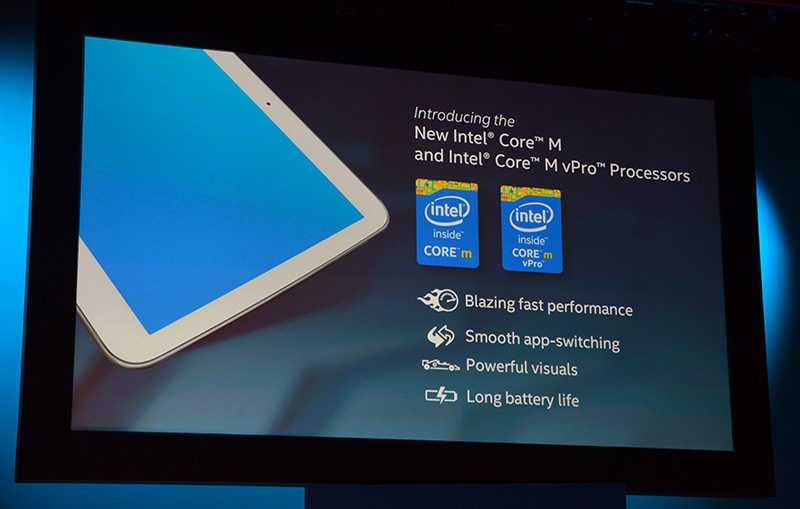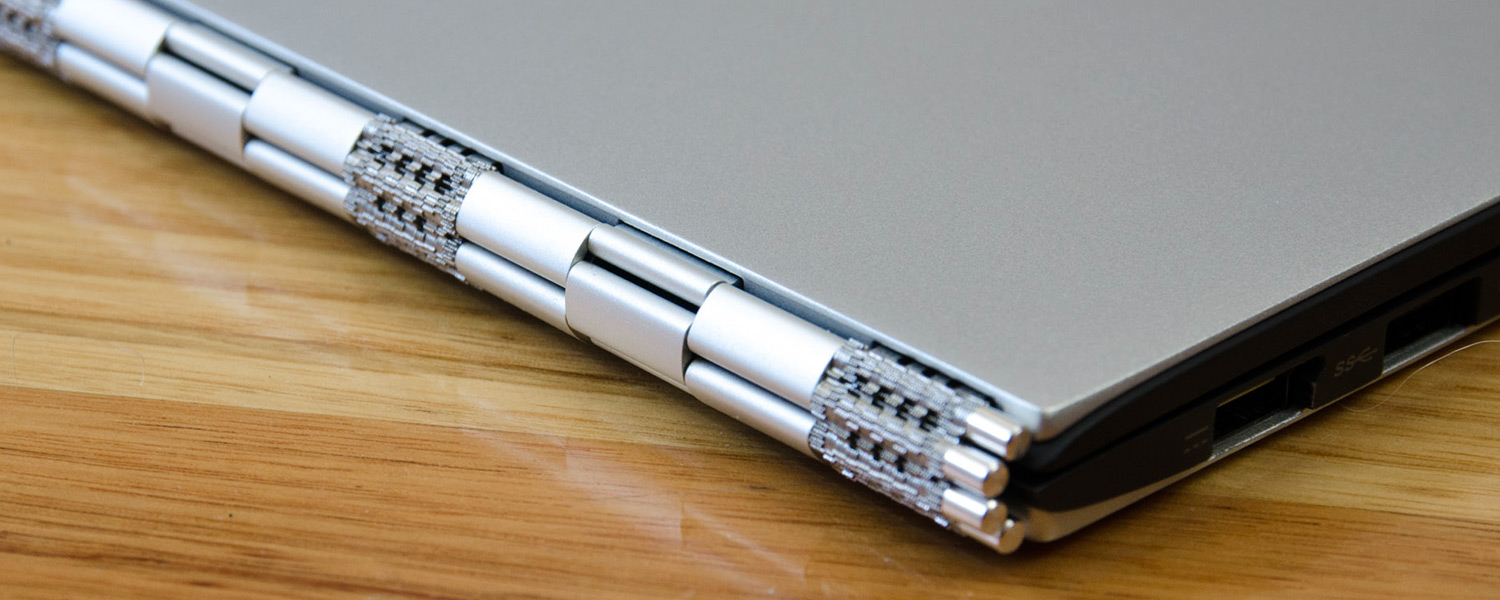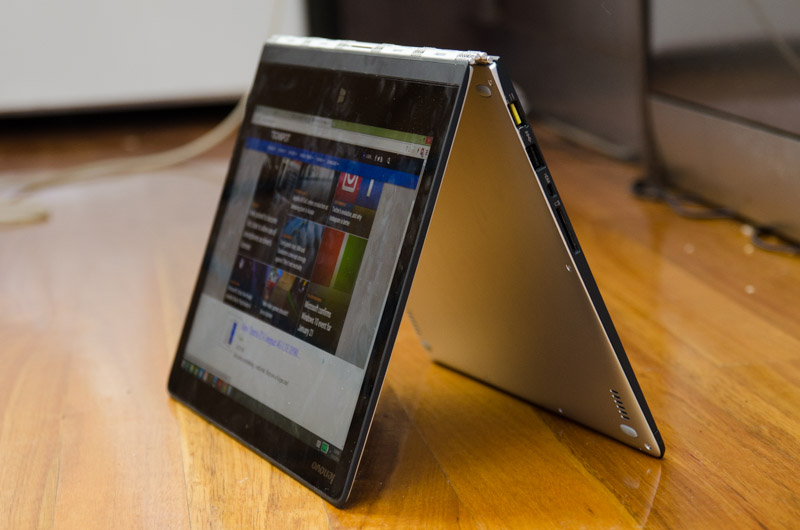Performance: Core M Overview and Impressions
The Yoga 3 Pro is the first device I've reviewed that's powered by one of Intel's new Broadwell chips. It's been an unusual launch for Intel, with the company choosing to release parts for low-power mobile platforms in advance of desktop and mainstream laptop SKUs. Typically all of these chips would be released at the same time and with more fanfare, but due to the higher performance parts being delayed into 2015, this has been a quiet and staggered launch for the processor giant.
The model used in the Yoga 3 Pro is the new Core M-5Y70, built on Intel's latest 14nm manufacturing process. It features two CPU cores and four threads, with a base clock speed of 1.1 GHz that's boosted up to 2.6 GHz where better single-thread performance is required.It also features Intel HD Graphics 5300 clocked up to 850 MHz, which is one of the lower end GPU parts that Intel will be manufacturing for Broadwell chips. It's a generational upgrade from the HD and Iris graphics in Haswell, but less powerful than the top end Iris (and Iris Pro) GPUs from that line.
The Core M-5Y70 also features 4M of L3 cache and vPro support, while the Yoga 3 Pro comes with 8 GB of dual-channel DDR3L-1600, providing 25.6 GB/s of bandwidth.

The most interesting part about this chip, though, is its TDP. The new Y-series Broadwell parts are rated at just 4.5W, down from 11.5W in the equivalent Haswell parts, though it's always hard to judge the real difference in power consumption in these SKUs that frequently adjust their clock speed. The main thing to note is that Broadwell is a more power efficient architecture, which should allow similar performance to Haswell at a lower power cost.
In the previous-generation Yoga 2 Pro, Lenovo used a Haswell-based Core i5-4210U, a 15W part with a base clock of 1.7 GHz and a Turbo frequency of 2.7 GHz. While the Turbo frequencies of the 5Y70 and 4210U are similar, there's a wider gap between the base clocks that will affect performance (negatively) and battery life (positively).
Generally speaking, the Yoga 3 Pro's Broadwell chip is slightly slower than typical low-power Haswell Ultrabooks that I've used in the past, but I'd hardly call it a large difference. Although Broadwell is marginally faster than Haswell clock-for-clock, the reduction in clock speeds for the new Y-series chips has reduced performance overall as Intel hunts for better energy efficiency.
It's also worth noting that Intel will have Broadwell parts available with higher TDPs and clock rates, which will be better suited for performance oriented systems. However with Ultrabooks such as the Yoga 3 Pro, battery life is key which is why Intel has made these performance/battery life compromises.
The Core M-5Y70 is still a capable performer throughout typical laptop usage scenarios. Web browsing with multiple tabs open, for example, is fast and responsive with performance only really suffering while scrolling media-heavy websites on the QHD+ display. Basic image manipulation in Photoshop and casual Windows Store app usage are also tasks that are easily possible on a laptop like the Yoga 3 Pro, editing Office documents and using other productivity software.
One thing I noticed, however, is that CPU usage can be quite high when performing the aforementioned tasks. Scrolling through an article on a website, for example, will see the CPU ramp up to around 40-50% usage, which seems quite high and can likely be attributed to the high display resolution. On my desktop rendering to a 1080p display, CPU usage is much lower in a similar scenario.

High CPU usage naturally increases heat output, and in situations like this I measured just over 40°C from the Yoga 3 Pro's hotspot towards the top right corner. It's good to see that this hotspot isn't in the middle of the keyboard or trackpad, but it can be a little uncomfortable for extended usage on a lap. The device gets even hotter under sustained load, such as gaming.
Speaking of gaming, I tried a few 3D games on the Yoga 3 Pro and found them to be unplayable. GRID 2 barely registered 20 FPS on Ultra Low settings at 1600 x 900, and reducing the resolution all the way down did not improve performance to above 30 FPS. Borderlands 2 was a similar story: on all low settings and a resolution of 1280 x 720 I couldn't get above 10 FPS, which is horrendous.
That said, if you wanted to play less intense 2D games like FTL, Rayman Origins or Super Meat Boy, you'll find the Yoga 3 Pro is capable of this. For anything more intense, the GPU simply isn't powerful enough.
As for wireless, the Lenovo Yoga 3 Pro uses Intel's Dual Band Wireless-AC 7265 chip for Wi-Fi 802.11a/b/g/n/ac support, and I had no issues with it connected to my dual-band wireless N network in my house. Performance was a little low on the 5 GHz band compared to some other devices around my house, but still good enough for streaming 1080p content. The Yoga also comes with Bluetooth 4.0, which again worked perfectly for me in my limited testing.
The Yoga 3 Pro comes with either 256 GB or 512 GB of internal SSD storage depending on the model you choose. Both of these options deliver plenty of storage for the average user, though you'll have to shell out an extra $200 to double the storage. Performance wise, I recorded 455 MB/s sequential read and 241 MB/s sequential write on the 256 GB model, which is decent enough.

Lenovo preloads Windows 8.1 64-bit onto the Yoga 3 Pro, although it's not the Pro version of the OS. There's also a bunch of bloatware to remove at your discretion, including McAfee Central, FilmOnTV, useless Microsoft Office and Adobe Creative Cloud launchers without the actual software installed, a generic PC App Store, and number of apps from the Windows Store such as Skype, eBay and Evernote.
You'll also find a number of Lenovo utilities on the device, some of which are quite useful. Lenovo Settings is a straightforward utility for configuring various aspects of the Yoga 3 Pro including the display and speakers. Harmony automatically recognizes which usage mode your laptop is currently in, and can optimize settings for the mode or app you're using at the touch of a button. It's also nice to see the usage statistics that list how often you use each mode.

